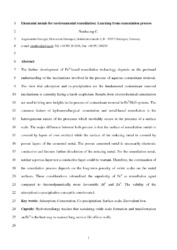Elemental metals for environmental remediation: learning from cementation process.
Preprint2010
DOI: https://doi.org/10.1016/j.jhazmat.2010.05.085
Persistent URL: http://resolver.sub.uni-goettingen.de/purl?gldocs-11858/7073
Persistent URL: http://resolver.sub.uni-goettingen.de/purl?gldocs-11858/7073
Noubactep, C., 2010: Elemental metals for environmental remediation: learning from cementation process.. In: Noubactep, C (2010): Elemental metals for environmental remediation: learning from cementation process. - Journal of hazardous materials, Vol. 181, Nr. 1-3, p. 1170-4, DOI: 10.1016/j.jhazmat.2010.05.085.
 |
Dokument öffnen: |
The further development of Fe(0)-based remediation technology depends on the profound understanding of the mechanisms involved in the process of aqueous contaminant removal. The view that adsorption and co-precipitation are the fundamental contaminant removal mechanisms is currently facing a harsh scepticism. Results from electrochemical cementation are used to bring new insights in the process of contaminant removal in Fe(0)/H(2)O systems. The common feature of hydrometallurgical cementation and metal-based remediation is the heterogeneous nature of the processes which inevitably occurs in the presence of a surface scale. The major difference between both processes is that the surface of remediation metals is covered by layers of own oxide(s) while the surface of the reducing metal in covered by porous layers of the cemented metal. The porous cemented metal is necessarily electronic conductive and favours further dissolution of the reducing metal. For the remediation metal, neither a porous layer nor a conductive layer could be warrant. Therefore, the continuation of the remediation process depends on the long-term porosity of oxide scales on the metal surfaces. These considerations rationalized the superiority of Fe(0) as remediation agent compared to thermodynamically more favourable Al(0) and Zn(0). The validity of the adsorption/co-precipitation concept is corroborated.
Statistik:
ZugriffsstatistikSammlung:
- Geologie [933]

